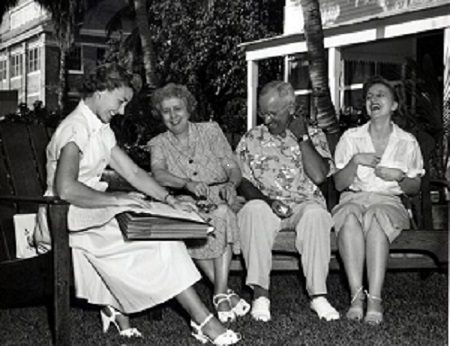 A census taker interviews the First Family (the Trumans) in 1950.
A census taker interviews the First Family (the Trumans) in 1950.
What activity was mandated by the U.S. Constitution in 1787 to occur within 3 years and be repeated every 10 years after to determine each state’s share of taxes and representation in Congress? If you answered the U.S. Federal Census you would be correct. The U.S. Census has been taken every 10 years from 1790 to 2010 and will be done again in 2020. Even though the original intent of the census was to determine the total population in the U.S., it has always included more information than just a head count. The questions changed and became more complex over the years as the federal government became interested in other kinds of demographic information. Since the 2000 census, the U.S. government has also conducted the American Community Survey in the years between the censuses to fill in the blanks and keep the demographic information up to date.
The information that is collected is used by government entities and businesses in a variety of ways. It not only determines tax share and the number of congressional representatives from each state but it’s also used for population statistics and business marketing purposes. The demographic data is available to the public at a county level as soon as it is published but the information is not available at an individual level until 72 years have passed from the official census date. This is what is called the 72 year privacy rule. So if the first census that you were alive for was the 1980 census, that census will not be available for researchers to examine at the individual level until 2052.
The kinds of questions to be asked on the Census and the American Community Survey in 2020 are not unusual. Questions about income, education, race, marital status, citizenship status and ethnicity have been asked for over 150 years.
Genealogists have found the U.S. Census to be an invaluable resource in tracking down your American ancestors. Because of the 72 year privacy rule, all U.S. Censuses from 1790 to 1940 are available for you to search and find your family. The 1950 census will be available for researchers in 2022. Which is only about 3 ½ years away. If you know of at least one member of your family who was alive during the 1940 census you should be able to follow your family backwards in time, skipping back every 10 years to the 1790 census.
How has the Census changed over the years?
From 1790 to 1840 the census asked for the name of the head of the household only and just recorded the number, gender and approximate age of other free individuals living in the home. Since the head of the household was usually the father, you are limited to searching for your free (not enslaved) adult male ancestors in most cases.
In 1850 and 1860 the census asked the name, age, sex, occupation, value of property and birthplace of every free person in the household. They were also interested in whether or not you could read and write, had attended school, were married and whether or not you were physically or mentally handicapped or a “pauper or convict”.
Also in 1850 and 1860 “slave schedules” were added that counted enslaved Americans but only recorded gender and age of each individual, not names. These schedules can only be searched if you know the location (county and state) where they lived or the name of the slave owner.
The 1870 census is significant in that this is the first census after the Civil War and thus the first census to include former enslaved African Americans by name. The questions were similar to the 1850 and 1860 census questions except each individual was also asked if their parents were foreign born and if each individual was a U.S. citizen.
The 1880 and 1900 census added questions about the respondents’ state of health and the birthplaces of both their father and mother. The 1890 census was almost completely destroyed by fire in 1921 and very little information remains to search. The 1890 census was the first census mechanically tabulated by machine.
In addition to most of the questions asked in 1900, the 1910 – 1930 censuses asked about the date of immigration of the individual and whether or not they had become a naturalized citizen. The 1910 census also had an Indian schedule which could be attached if needed (for example on an Indian Reservation) and also asked if the respondent was a Civil War veteran. In 1930 they asked if the family owned a radio because the government was just setting up what became known as the “Emergency Broadcasting System” and wanted to know if it radio notices would effectively reach most Americans.
In 1940 the Census added questions about where the individual resided in 1935 and whether or not they had used government assistance because of the hardships wrought by the great depression.
Later censuses asked fewer questions and relied more on sampling data. Every household filled out a short form but only a portion of homes filled out a more detailed survey of up to 45 questions. The 1950 census was the first census tabulated by computer. The 2020 census will be the first census largely completed over the Internet.
If you’d like to know more about the U.S. Census and how the data collected is used, here are some recommended websites to consult:
American Community Survey https://www.census.gov/programs-surveys/acs/
Census.gov https://www.census.gov/
History of the U.S. Census
https://www.history.com/news/10-things-you-may-not-know-about-the-u-s-census
https://en.wikipedia.org/wiki/United_States_Census
Research using U.S. Federal Census Records https://www.archives.gov/research/census
Elaine Jones Hayes
Assistant Manager Reference Services/ Special Collections Librarian
Laramie County Library System
December 2018
